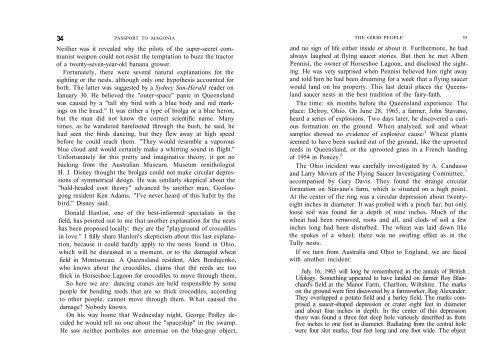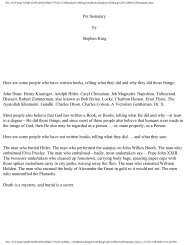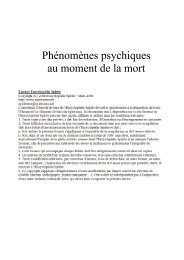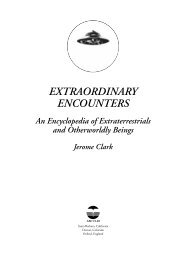Create successful ePaper yourself
Turn your PDF publications into a flip-book with our unique Google optimized e-Paper software.
34 PASSPORT TO MAGONIA<br />
Neither was it revealed why the pilots of the super-secret communist<br />
weapon could not resist the temptation to buzz the tractor<br />
of a twenty-seven-year-okl banana grower.<br />
Fortunately, there were several natural explanations for the<br />
sighting or the nests, although only one hypothesis accounted for<br />
both. The latter was <strong>suggested</strong> by a Sydney Sun-Herald reader on<br />
January 30. He believed the "outer-space" panic in Queensland<br />
was caused by a "tall shy bird with a blue body and red markings<br />
on the head." It was either a type of brolga or a blue heron,<br />
but the man did not know the correct scientific name. Many<br />
times, as he wandered barefooted through the bush, he said, he<br />
had seen the birds dancing, but they flew away at high speed<br />
before he could reach them. "They would resemble a vaporous<br />
blue cloud and would certainly make a whirring sound in flight."<br />
Unfortunately for this pretty and imaginative theory, it got no<br />
backing from the Australian Museum. Museum ornithologist<br />
H. J. Disney thought the brolgas could not make circular depressions<br />
of symmetrical design. He was similarly skeptical about the<br />
"bald-headed coot theory" advanced by another man, Gooloogong<br />
resident Ken Adams. "I've never heard of this habit by the<br />
bird," Disney said.<br />
Donald Hanlon, one of the best-informed specialists in the<br />
field, has pointed out to me that another explanation for the nests<br />
has been proposed locally: they are the "playground of crocodiles<br />
in love." I fully share Hanlon's skepticism about this last explanation,<br />
because it could hardly apply to the nests found in Ohio,<br />
which will be discussed in a moment, or to the damaged wheat<br />
field in Montsorcau. A Queensland resident, Alex Bordujcnko,<br />
who knows about the crocodiles, claims that the reeds arc too<br />
thick in Horseshoe Lagoon for crocodiles to move through them.<br />
So here we are: dancing cranes are held responsible by some<br />
people for bending reeds that are so thick crocodiles, according<br />
to other people, cannot move through them. What caused the<br />
damage? Nobody knows.<br />
On his way home that Wednesday night, George Pedley decided<br />
he would tell no one about the "spaceship" in the swamp.<br />
He saw neither portholes nor antennae on the blue-gray object,<br />
THE GOOD PEOPLE 35<br />
and no sign of life either inside or about it. Furthermore, he had<br />
always laughed at flying saucer stories. But then he met Albert<br />
Pennisi, the owner of Horseshoe Lagoon, and disclosed the sighting.<br />
He was very surprised when Pennisi believed him right away<br />
and told him he had been dreaming for a week that a flying saucer<br />
would land on his property. This last detail places the Queensland<br />
saucer nests in the best tradition of the fairy-faith.<br />
The time: six months before the Queensland experience. The<br />
place: Delroy, Ohio. On June 28, 1965, a farmer, John Stavano,<br />
heard a series of explosions. Two days later, he discovered a curious<br />
formation on the ground. When analyzed, soil and wheat<br />
samples showed no evidence of explosive cause/ 1 Wheat plants<br />
seemed to have been sucked out of the ground, like the uprooted<br />
reeds in Queensland, or the uprooted grass in a French landing<br />
of 1954 in Poncey. 6<br />
The Ohio incident was carefully investigated by A. Candusso<br />
and Larry Movers of the Flying Saucer Investigating Committee, 7<br />
accompanied by Gary Davis. They found the strange circular<br />
formation on Stavano's farm, which is situated on a high point.<br />
At the center of the ring was a circular depression about twentyeight<br />
inches in diameter. It was probed with a pinch bar, but only<br />
loose soil was found for a depth of nine inches. Much of the<br />
wheat had been removed, roots and all, and clods of soil a few<br />
inches long had been disturbed. The wheat was laid down like<br />
the spokes of a wheel; there was no swirling effect as in the<br />
Tully nests.<br />
If we turn from Australia and Ohio to England, we are faced<br />
with another incident:<br />
July 16, 1963 will long be remembered in the annals of British .<br />
Ufology. Something appeared to have landed on farmer Roy Blanchard's<br />
field at the Manor Farm, Charlton, Wiltshire. The marks<br />
on the ground were first discovered by a farmworker, Reg Alexander.<br />
They overlapped a potato field and a barley field. The marks comprised<br />
a saucer-shaped depression or crater eight feet in diameter<br />
and about four inches in depth. In the center of this depression<br />
there was found a three feet deep hole variously described as from<br />
five inches to one foot in diameter. Radiating from the central hole<br />
were four slot marks, four feet long and one foot wide. The object





